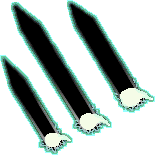
If you followed an outside link directly to this page, start here for an overview.
Take a look at the vowels, pulled out of the rest of the alphabet and lined up side by side:
 |
 |
 |
 |
 |
| a | e | i | o | u |
(TRIVIA: Why isn't there a tightly-spaced horizontal-line vowel? Because in some other languages, ClaWrite distinguishes between hard and soft "I"s, and doing it this way meant the vowel progression could stay the same. Now you know.)
 |
 |
 |
 |
 |
 |
 |
 |
| b | c | d | f | g | h | j | k |
 |
 |
 |
 |
 |
 |
 |
 |
 |
| l | m | n | p | qu | r | s | t | v |
Also, don't confuse the "v" character for a "u". Remember, vowels' lines go in a single direction!
 |
 |
 |
 |
 |
 |
 |
 |
 |
| w | x | y | z |
![[triple-horizontal-bar]](cap.gif)  |
 |
| E | e |
In informal use, the "corner" grids can be reduced to a single, curved slash in the appropriate corner. In formal use, the whole character is used. I've reprinted both characters below.
   |
   |
   |
   |
| . | , | ? | ! |
| | |||
| "Full stop." Reading left to right, the horizontal lines lead you into a wall. | "Pause." Reading left to right, you hit a wall, but the horizontal lines lead you forward. | This is the one that looks like a question mark. | The corner is on top, but it doesn't look like a question mark. :) |
The ellipsis ("...") deserves special mention, as it's one of only two common uses of diagonal slashes in ClaWrite: rather
than abbreviating three consecutive periods as ",,," -- which would require individual attention to each of the curved
strokes -- many folks prefer to use "///", which can be drawn with a single slash of the claws.
On the other hand, some people prefer to use diagonal strokes for numeric digits, and the /// ellipsis conflicts with
that. So it's your choice whether to do this or not.
 |
  |
  |
 |
 |
| ’ | “ ” | ( ) | ; | : |
First:  is the symbol for th. In other languages, this is used to draw a distinction between hard-stop
(t') and soft (th) pronunciations. But in English, you can simply use it to save yourself a few characters for a common letter pair.
is the symbol for th. In other languages, this is used to draw a distinction between hard-stop
(t') and soft (th) pronunciations. But in English, you can simply use it to save yourself a few characters for a common letter pair.
Second: You may notice that we haven't yet seen the character where every position in the grid is filled --

There's no single character that uses all of the slashes. This makes it available for such uses as section breaks, if you need to switch thoughts mid-line, or to set off important material.
Alternatively -- and informally -- ClaWrite users can use this as a one-character curse word. Consider it the claw-slash equivalent of mashing both hands down on the keyboard to produce a gibberish expletive like "DSVOPIH!"
And on that dignified note, let's put to use the skills we've just learned. Why not go decipher a classic poem rewritten in ClaWrite?
Up to ClaWrite index |
Please report errors or broken links to the webmaster via the Contact page. Page created Dec 16, 2007. Last updated Dec 16, 2007. Design © 1997-2007 Tad "Baxil" Ramspott. |